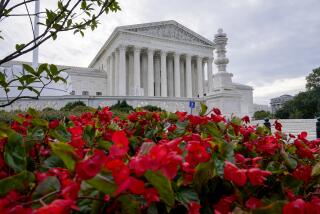High court delivers no decision in age-discrimination case
- Share via
WASHINGTON — The Supreme Court on Tuesday decided not to decide one of its most closely watched job discrimination cases. The non-decision was unanimous.
At issue was whether a laid-off older worker who sued her employer for age bias could rely on the testimony of other older workers who also were fired from the same company.
A federal trial judge had excluded testimony from five co-workers in the age-bias case brought by Ellen Mendelsohn, a 51-year manager who was dismissed by Sprint’s headquarters near Kansas City. The judge said in a two-sentence order that the plight of these co-workers was not relevant because they had been fired by other supervisors, not the supervisor who laid off Mendelsohn.
Taking the opposite view, the U.S. 10th Circuit Court of Appeals in Denver said this kind of testimony always should be heard because it is “relevant to [the company’s] animus toward older workers.”
On Tuesday, the high court said both views were wrong.
So when should testimony from other workers be heard in job-bias cases?
The justices gave no answer. It “depends on many factors, including how closely related the evidence is to the plaintiff’s circumstances and theory of the case,” said Justice Clarence Thomas in Sprint vs. Mendelsohn.
The justices gave no signal whether the co-workers should or should not be heard in this case. Instead, they sent it back to the trial judge to start over and explain her thinking in greater detail.
That didn’t stop the advocates on both sides from proclaiming victory. The adversaries said they were delighted the court had rejected their opponent’s claim.
“We won,” said Paul W. Cane Jr., a San Francisco lawyer who represented Sprint. “The court unanimously rejected the 10th Circuit’s rule” that would have included all such testimony from co-workers. “And that’s a win in anybody’s book,” he said.
“The bottom line is I’m happy,” said Dennis E. Egan, a lawyer in Kansas City who represented Mendelsohn. “Sprint and the business community had urged the court to say this evidence is never admissible, and the court said no to that.”
Others who had closely followed the case also had contrary reactions.
The National Federation of Independent Business proclaimed victory in a statement. The group said it was “pleased that the court ruled against allowing ‘me too’ evidence to be used in all employment discrimination cases.”
AARP, the advocacy group for older Americans, also was gratified. “We are pleased with the decision because of what could have been the result,” said Daniel B. Kohrman, an attorney for the group. “The business community was seeking a sweeping exclusion of testimony from co-workers, and that doesn’t reflect the reality of the workplace.”
It is not unusual for the high court to disagree with both a trial judge and an appeals court in the same case. It is unusual, however, for the justices to not set forth a rule of law to be followed in the future.
Both of the advocates agreed on that point.
“That is the frustrating part here. We thought the court would provide more guidance,” said Egan, Mendelsohn’s lawyer.
Cane, Sprint’s lawyer, said: “The court could have helped by laying out more precise markers. This means there will be future fights over whether this kind of evidence can be admitted.”
--
More to Read
Get the L.A. Times Politics newsletter
Deeply reported insights into legislation, politics and policy from Sacramento, Washington and beyond. In your inbox twice per week.
You may occasionally receive promotional content from the Los Angeles Times.











